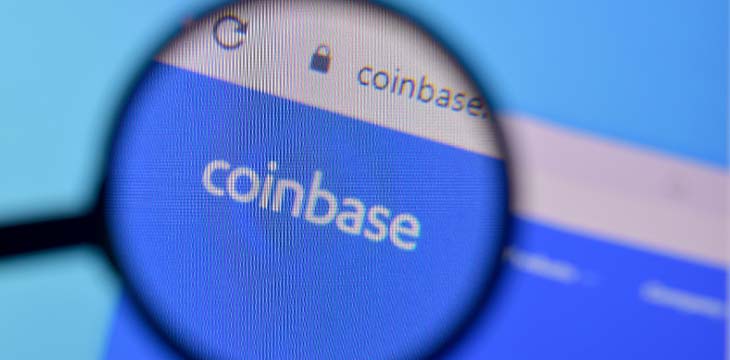|
Getting your Trinity Audio player ready...
|
U.S.-based ‘crypto’ exchange Coinbase (NASDAQ: COIN) is considering adding another 50 tokens to its trading list in an apparent bid to boost both its share price and venture capital exit liquidity.
On April 11, Coinbase released a list of 50 tokens “under consideration for listing” in the current quarter ending June 30. The bulk of these are ERC-20 tokens on the Ethereum network, while five are SPL tokens on the Solana network.
The former group includes some familiar names, such as stablecoins issued by Binance (BUSD) and Gemini (GUSD), as well as the BitDAO project’s BIT token. But there’s also some truly left-field choices, some of which were released four years ago and pretty much sank without a trace. It’s enough to crane one’s neck in search of the vendor yelling “Program! Program! Can’t tell the shitcoin without a program!”
There was a point in the not too distant past when the cryptocurrency exchange was far more cautious in choosing which tokens to list, a stance perhaps dictated by the exchange’s decision to remain based in the U.S., where regulators continue to view the digital asset sector with suspicion.
But a new regime arrived during Coinbase’s Q1 2021 earnings call when CEO Brian Armstrong said “we need to accelerate the process by which we review assets and we add them to the site.” Whereas the previous decision to list was based on a token having “reached some substantial scale,” the new plan was to “be first to list the number of these coins. And that’s going to be really important to our business.”
Just how important became apparent this January, as the Financial Times released a damning report that showed Coinbase failed to publicly disclose its financial interest in a number of the tokens it chose to list on its site. Coinbase subsequently declared that it would make its investments “even more transparent,” which wouldn’t be that hard, given that any information whatsoever would definitely trump the zero data the exchange and its VC arm Coinbase Ventures previously provided to consumers.
It was the janitor in the boardroom with the candlestick
Coinbase claims to abide by a policy that “prevents board members or Coinbase employees from being involved in a listing decision where they have a financial interest.” Yet in a sector in which the VC giants—a16z, Paradigm Capital, Union Square Ventures, the new Haun Ventures—all have seats on Coinbase’s board of directors, the policy conjures up images of Armstrong sitting in an empty room talking to himself, before ultimately remembering to recuse himself and then just leaving the decision up to the janitor who comes in at night and sees the proposed token listing sheets lying on the table.
The usual VC suspects may not have a dominant interest in the 50 tokens that Coinbase is currently considering listing, but that could simply be a smokescreen for future listings that are loaded with tokens the major VCs are looking to unload on unsuspecting retail investors.
Previous Coinbase listings have shown a distinct pattern for most VC-backed tokens, as detailed here by Fais Khan. In a nutshell, there’s a very brief post-listing window of significant price gains that creates even more FOMO among retail investors, followed by a swan dive into a deep ocean of negative returns, from which most tokens never recover.
Tellingly, tokens backed by either Coinbase or a16z show worse returns over time, while those backed by both firms perform worst of all. And VC-backed tokens that Coinbase decides not to list outperform the listed versions, for which Khan posits two theses: “(1) that most coins appreciate due to illiquidity, not value (as both listings and non-listings suffer degradation over time) (2) that the liquidity on Coinbase causes these coins to underperform, perhaps in part due to insider selling.”
The scam is coming from inside the house!
Coinbase is far from the only major ‘crypto’ player suspected of insider hijinks, as similar allegations have been made against other exchanges with equally ‘arms-length’ entities focused on investment and market-making—like the FTX exchange and its Alameda Research offshoot.
While these entities will swear they’re as pure as the driven snow, don’t forget that FTX founder Sam Bankman-Fried has gone on record saying he appended the name ‘Research’ to Alameda in order to fool financial institutions that wanted nothing to do with crypto-related projects.
The opacity of the interactions between exchanges and their market-makers—or between exchanges and affiliated VCs—creates untold opportunities for front-running retail customers. It’s a level of coziness with double-dealing that wouldn’t fly in the traditional financial sector.
Take, for example, the fact that sharp-eyed Twitterati uncovered an ETH address that invested some $400,000 into six of the unexceptional tokens on Coinbase’s new ‘considering’ list the day before the list was published. This very canny investment was up nearly 50% in the immediate aftermath of the list’s publication.
This isn’t the first time such prescient prognostication has emerged before a Coinbase listing plan became public knowledge. Yet what is the fallout from such blatant examples of insider trading? Nish. Nada. Nothing. The ‘crypto’ community just rolls its eyes, shrugs its shoulders and goes back to screaming at the flaccid BTC/ETH tokens for failing to reach the moon already.
In many ways, this is not unlike the strategy employed by controversial politicos such as Donald Trump and Boris Johnson. Both men are notorious for careening from one scandal to the next, but there’s never sufficient time for the public outrage machine to gain traction before an entirely new, even more outrageous scandal emerges, after which the machine resets and the process repeats itself anew.
Save us, student coin!
Coinbase’s share price hit a 52-week low this week, briefly dipping below $150, less than half of its direct listing price and barely one-third of its all-time peak on the day Coinbase made its Nasdaq debut. Which could explain the exchange’s determination to list every token under the sun: reaping a host of new trading fees from FOMO’d retail investors while simultaneously allowing VCs to recoup their investment by dumping their pre-mined tokens.
But the net effect of this pump-dump-wash-rinse-repeat cycle is the unnecessary proliferation of utterly useless tokens out there in the wild. In addition to clogging up perpetually congested networks such as Ethereum, they’re also clogging up the public consciousness, providing fodder for blockchain skeptics to dismiss the entire sector as just a giant utility-free Ponzi scheme.
Isn’t it ironic, then, that the one token Coinbase has yet to deem fit for listing is Bitcoin SV (BSV), the only blockchain that has so far demonstrated the capacity to scale with ultra-low transaction costs that allow it to serve as the peer-to-peer electronic cash described in the 2008 Bitcoin white paper?
It’s almost as if they recognize that mass adoption of BSV would render the whole token speculation market redundant, which would have serious repercussions for those out to bleed the unsuspecting masses dry. As Katie Haun admitted before she left a16z to form her own crypto-focused VC, “the majority of our funds are deployed in tokens.” And like they say, when the only thing in your toolbox is a flamethrower, you tend to want to burn everything to the ground.
Uncle Sam, on the other hand, has a number of items in his toolbox, including stiff financial penalties and even incarceration. Those who are currently gaming the system to their advantage may eventually find themselves with a lot of extra ‘time’ on their hands. When that day comes, I suggest they take another look at BSV and see what they might have accomplished had they spent their days building instead of scamming.
Follow CoinGeek’s Crypto Crime Cartel series, which delves into the stream of groups—a from BitMEX to Binance, Bitcoin.com, Blockstream, ShapeShift, Coinbase, Ripple,
Ethereum, FTX and Tether—who have co-opted the digital asset revolution and turned the industry into a minefield for naïve (and even experienced) players in the market.

 01-04-2026
01-04-2026 




